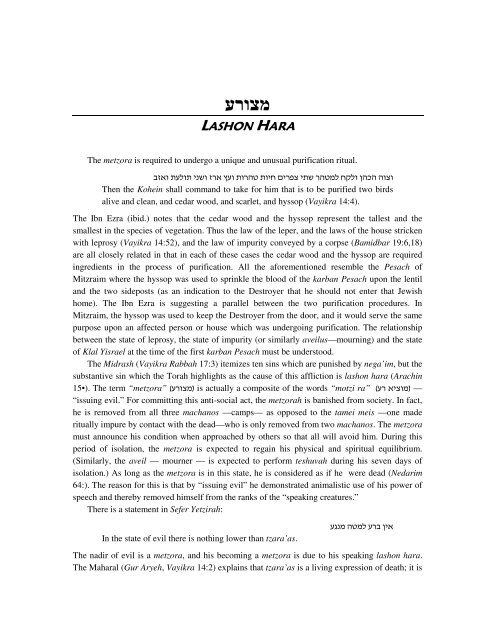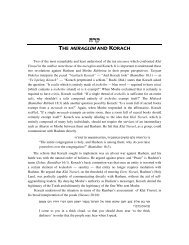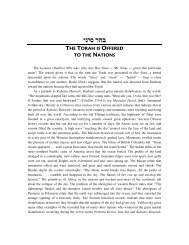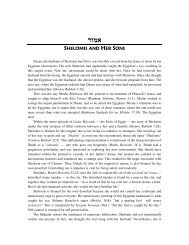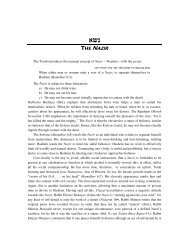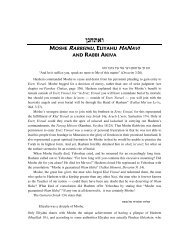Lashon Hara - Parsha Illuminations
Lashon Hara - Parsha Illuminations
Lashon Hara - Parsha Illuminations
Create successful ePaper yourself
Turn your PDF publications into a flip-book with our unique Google optimized e-Paper software.
מצורע<br />
LASHON HARA<br />
The metzora is required to undergo a unique and unusual purification ritual.<br />
וצוה הכהן ולקח למטהר שתי צפרים חיות טהרות ועץ ארז ושני תולעת ואזב<br />
Then the Kohein shall command to take for him that is to be purified two birds<br />
alive and clean, and cedar wood, and scarlet, and hyssop (Vayikra 14:4).<br />
The Ibn Ezra (ibid.) notes that the cedar wood and the hyssop represent the tallest and the<br />
smallest in the species of vegetation. Thus the law of the leper, and the laws of the house stricken<br />
with leprosy (Vayikra 14:52), and the law of impurity conveyed by a corpse (Bamidbar 19:6,18)<br />
are all closely related in that in each of these cases the cedar wood and the hyssop are required<br />
ingredients in the process of purification. All the aforementioned resemble the Pesach of<br />
Mitzraim where the hyssop was used to sprinkle the blood of the karban Pesach upon the lentil<br />
and the two sideposts (as an indication to the Destroyer that he should not enter that Jewish<br />
home). The Ibn Ezra is suggesting a parallel between the two purification procedures. In<br />
Mitzraim, the hyssop was used to keep the Destroyer from the door, and it would serve the same<br />
purpose upon an affected person or house which was undergoing purification. The relationship<br />
between the state of leprosy, the state of impurity (or similarly aveilus—mourning) and the state<br />
of Klal Yisrael at the time of the first karban Pesach must be understood.<br />
The Midrash (Vayikra Rabbah 17:3) itemizes ten sins which are punished by nega’im, but the<br />
substantive sin which the Torah highlights as the cause of this affliction is lashon hara (Arachin<br />
15•). The term “metzora” ( ) is actually a composite of the words “motzi ra” ( ) —<br />
“issuing evil.” For committing this anti-social act, the metzorah is banished from society. In fact,<br />
he is removed from all three machanos —camps— as opposed to the tamei meis —one made<br />
ritually impure by contact with the dead—who is only removed from two machanos. The metzora<br />
must announce his condition when approached by others so that all will avoid him. During this<br />
period of isolation, the metzora is expected to regain his physical and spiritual equilibrium.<br />
(Similarly, the aveil — mourner — is expected to perform teshuvah during his seven days of<br />
isolation.) As long as the metzora is in this state, he is considered as if he were dead (Nedarim<br />
64:). The reason for this is that by “issuing evil” he demonstrated animalistic use of his power of<br />
speech and thereby removed himself from the ranks of the “speaking creatures.”<br />
There is a statement in Sefer Yetzirah:<br />
מוציא רע<br />
אין ברע למטה מנגע<br />
מצורע<br />
In the state of evil there is nothing lower than tzara’as.<br />
The nadir of evil is a metzora, and his becoming a metzora is due to his speaking lashon hara.<br />
The Maharal (Gur Aryeh, Vayikra 14:2) explains that tzara’as is a living expression of death; it is
the manifestation of death in a breathing creature, making the metzora the lowest form of human<br />
existence (see Kuzari III:60).<br />
The Gemara (Sotah 42•) lists four groups of people who will not be privileged to encounter<br />
the Shechinah: the scoffers, the liars, the flatterers, and the purveyors of evil talk. He who speaks<br />
evil is as one who denies the existence of the Almighty (Arachin 15:). The sin is tantamount to<br />
the three cardinal sins: idolatry, incest and murder (ibid.) for which one is responsible to offer his<br />
life in an attempt to avoid trespass. Interestingly, Rabbeinu Yonah (Sha’arei Teshuvah 3:231)<br />
even includes in the category of lashon hara the trait of complaining or whining about life, and he<br />
explains that this group will not be included among those who will be worthy to greet the<br />
Shechinah.<br />
Our sages consider which is the more serious sin: ona’as mamon — vexing one’s fellow man<br />
with money — or ona’as devarim — vexing one’s fellow man with words (Bava Metzia 58:).<br />
They conclude that the sin of vexing with words is associated with the pasuk, “You shall fear<br />
Hashem” (Vayikra 25:17) while monetary vexation is not associated with this pasuk. Also, a<br />
financial crime can always be reversed with compensation, while a verbal crime can never be<br />
completely restituted. Of course, one may apologize for an insult, but complete teshuvah is<br />
impossible. How can one remove the hurt suffered by an insulted fellow man?<br />
The Gemara (Bava Basra 9:) states that there are six blessings rewarded to the giver of<br />
charity, while there are eleven blessings associated with being cordial to a fellow human being.<br />
Hence, greater emphasis is placed on displaying civility to a fellow human being than in even<br />
financially supporting him.<br />
טוב המלבין שינים לחבירו יותר ממשקהו חלב<br />
A sincere smile to a fellow man is more praiseworthy than even feeding him<br />
(Kesubos 111:).<br />
The importance of courteous, civil conduct cannot be overstated, and it is a cornerstone of Torah<br />
existence. The metzora who violates this code of social behavior removes himself from the living<br />
community, and therefore his sin is considered among the vilest and most contemptible. The<br />
contagious aspect of the state of the metzora is his bad behavior — hence, his forced isolation.<br />
The other rite involving the hyssop, was the blood of the karban Pesach at Yetzias Mitzraim.<br />
From time immemorial mankind has sought to identify itself with Hashem via an animal<br />
sacrifice. Kayin and Hevel brought offerings to Hashem (Bereishis 4:3-4), Adam brought<br />
karbanos (Avodah Zarah 8•), Noach offered a sweet savor to Hashem (Bereishis 8:20), and this<br />
was the custom of all mankind through all the generations. All their offerings were burnt<br />
offerings — an offering that was completely consumed by fire. When Klal Yisrael came onto the<br />
scene with their karban Pesach, they were instructed by Hashem to “eat the flesh” of the karban<br />
(Shemos 12:8). This is the first time in human history that a human being had the audacity to<br />
share with Hashem in His karban. Klal Yisrael became, so to speak, partners with Hashem in the<br />
karban. What was up to now totally consumed by fire, could now also be consumed by the<br />
corporeal bodies of Klal Yisrael, and it would be considered as if it were offered up on an altar<br />
completely consumed by fire.<br />
This gives new dimension to the exclamation of Shlomo Hamelech:
עורי צפון ובואי תימן<br />
“Awake, O’ north, and come you of the south” (Shir Hashirim 4:16).<br />
Traditionally, the nations of the world were referred to as the “north,” while Klal Yisrael was<br />
referred to as the “south.” Thus, the verse is actually saying, “Awake, you nations of the north,<br />
for Klal Yisrael of the south is now coming. Awake, you nations of the north — whose karbanos<br />
(the karban olah) were always restricted to the north side of the mizbei’ach. For now Klal Yisrael<br />
is emerging on the scene; they are not restricted to the north side of the mizbei’ach — they can<br />
also offer a karban shelamim (a karban Pesach is of the shelamim family) which is sacrificed on<br />
the south side of the mizbei’ach. Klal Yisrael will now partake of karbanos together with<br />
Hashem. Klal Yisrael is no longer just another nation like other nations of the world — Klal<br />
Yisrael is now elevated to the status of super-nation. There are the nations of the world, and then<br />
there is Klal Yisrael” (see Midrash Rabbah, Bereishis 34:9).<br />
חביב אדם שנברא בצלם<br />
Beloved is man, for he was created in the image of Hashem (Pirkei Avos 3:14).<br />
Every human being is beloved by Hashem, whether Jew or non-Jew.<br />
חביבים ישראל שנקראו בנים למקום<br />
Most beloved is Yisrael, for they are called children of Hashem (ibid.).<br />
It was an act of special favor that it was disclosed to Klal Yisrael that they are called the “children<br />
of Hashem.” No other nation can share with Hashem in His sacrificial offerings; but a son may<br />
eat of his Father’s table. The karban Pesach inaugurated a new era for mankind, an era in which<br />
Klal Yisrael were permitted to share with Hashem in eating certain karbanos.<br />
In effect, the elevated status of Klal Yisrael was reflected in their superior Tzelem Elokim —<br />
Image of G-d. The Tiferes Yisrael (ibid.) discloses that certain individuals of the nations possess<br />
Tzelem Elokim, but on the whole, the other nations may have forfeited their Tzelem image due to<br />
their wickedness. Klal Yisrael will never entirely lose the Tzelem because of its special<br />
relationship with Hashem. This new status of Tzelem Elokim was expressed by the uniqueness of<br />
the karban Pesach offering.<br />
On the other hand, the Metzora seeks to destroy and break down the inherent Tzelem Elokim<br />
of his fellow human being. By belittling and embarrassing his peer, the metzora ignores and even<br />
attempts to dismiss another human being’s Tzelem. Hence, as part of his purification rite, he must<br />
return to basics. The metzora is reintroduced to the hyssop which was used during Pesach<br />
Mitzraim to demonstrate the nobility and aristocracy of each individual member of Klal Yisrael.<br />
As part of his re-assimilation into civil society, he must relearn the lesson of Pesach Mitzraim.<br />
The Ch’sam Sofer (Derashos 594) points out that the hyssop specifically was used on Pesach<br />
(in Mitzraim) because it is the smallest of bushes. Its purpose was to remind Klal Yisrael:<br />
לא מרבכם מכל העמים חשק ה' בכם, ויבחר בכם כי אתם המעט מכל העמים<br />
Not because you are a majority among the nations did Hashem love you. He<br />
choose you because you were the fewest of all people (Devarim 7:7).<br />
. . . how shall Yaakov stand? for he is small (Amos 7:2).<br />
מי יקום יעקב כי קטן הוא
Nevertheless, Hashem chose you. Not necessarily due to your own merit, but because:<br />
רק באבתיך חשק ה' לאהבה אותם, ויבחר בזרעם אחריהם בכם מכל העמים<br />
Only that Hashem had a delight in your fathers to love them, and He chose their<br />
seed after them, even you above all people (Devarim 10:15).<br />
The bush, which is the smallest of vegetation, reminds the nation that is smallest in number to<br />
rejoice in their exalted status (See Shabbos 67a; Bamidbar Rabbah 19:3). Traditionally, Klal<br />
Yisrael is aware of its exalted status, nevertheless their personal behavior is one of self-imposed<br />
minimization (Chulin 89•).<br />
This attitude of minimization is a tenet of Torah life. Reconciling avowed national elitism<br />
with exacting personal deprecation is the mark of the Torah individual. The common thread of the<br />
state of leprosy, the state of impurity, the state of aveilus and the karban Pesach is to teach this<br />
fundamental lesson.<br />
aA


